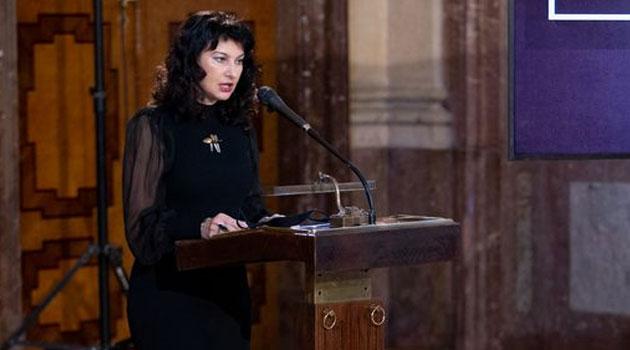Jana Horváthová: Romani suffering began long before the Second World War

Jana Horváthová, director of the Museum of Romani Culture in Brno, Czech Republic, reminded those who gathered in the Senate for the ceremonial commemoration of the Day of Holocaust Remembrance and Prevention of Crimes against Humanity what the circumstances of the Holocaust were for Romani victims and those who aided and tolerated those murders. She informed her listeners that Romani suffering began here long before the Second World War.
“Their suffering during World War II was a real genocide, they experienced the Holocaust, but quite frequently the public does not know this – or, even more often, does not accept this fact. Some people either do not know, or do not want to know, that Romani suffering began long before World War II,” Horváthová said in her speech, which news server Romea.cz is publishing in full translation below.
27 January 2022 remarks
Dear survivors and descendants of survivors, dear exceptional figures here in the Senate, dear ladies and gentlemen following online,
A lot has been said about the Holocaust and the Shoah – maybe everything has already been said.
The poet Vít Slíva concisely captures the limited possibilities of words in one of his verses: “When she draws circles and puts apples in them / She sees how much is missing to make words full.” There is a lot we do not know, and we will probably never rediscover what has been hidden from us – namely, the experiences of the individual, personal tragedies, their depth, their universe. Because, as Primo Levi says: “We who survived the Camps are not true witnesses. […] We are those who, through prevarication, skill or luck, never touched bottom. Those who did, and who have seen the face of the Gorgon, did not return, or returned wordless.”
Again, it was Hannah Arendt who said: “Refugees driven from country to country represent the vanguard of their peoples – if they keep their identity. For the first time Jewish history is not separate but tied up with that of all other nations. The comity of European peoples went to pieces when, and because, it allowed its weakest member to be excluded and persecuted.” Arendt speaks of the Jewish nation, and in that same place we can imagine the member who is weakest as the Roma. Their suffering during World War II was an actual genocide, they experienced the Holocaust, but quite frequently the public does not know this – or, even more often, does not accept this fact. Some people either do not know, or do not want to know, that Romani suffering began long before World War II.
Aliens for all eternity. Those on the fringes of society. The rural scourge. The Gypsy eyesore. The Gypsy nuisance. “Black Jews”.
Interwar society had these and many other designations for the Roma and Sinti, and the headlines in the period press illustrate this well. Before the Second World War, the Roma – or as they were exclusively referred to at the time, the Gypsies – were perceived on the one hand through a distorted, romantic view as exotic elements, as eye-catching figures in the form of the frequently kitschy decorations and paintings hanging in the apartments of the petit bourgeois, and on the other hand they were seen as aliens, as a difficulty that needed to be controlled, managed, tamed with the help of the gendarmerie. These tendencies were then embodied in Czechoslovakia’s “Act on Wandering Gypsies” of 1927. At the time it was even known that the law violated the Constitution in several of its sections, but it fit with the relationship society had toward this minority, whose members were very disparate and did not form a single unit (although the majority society did perceive those whom they called “Gypsies” as such a unit). After all, the absence of a definition of the term “gypsy”, the deliberate freedom for its interpretation in the law, and the creation of room for authorities and police to take that interpretation into their own hands meant that the law did not affect just those termed “wandering gypsies”, i.e., those who lived on the road, but also made it possible to punish Romani people for their origin irrespective of their actual lifestyle, as well as non-Romani people living what was being called the “gypsy way of life”. All of these people were then obliged to carry so-called “gypsy ID cards”, while all other citizens were issued regular identification cards by the state.
Fantasies of internment were not unknown during the interwar period, and with the advent of Nazism and the politics of racism in neighboring Germany, a significant part of the Czechoslovak public began calling for more radical solutions than the law that has been mentioned, or fingerprints on “gypsy ID cards”, especially in the pages of the agrarian press. In the archives we can find gendarmes’ and officials’ proposals to “set up concentration camps or criminal labor units” for “gypsies”, since then they would have a place to live, a place to work, and they would no longer bother the decent fellow-citizens in their vicinity. Proposals were made to sterilize “gypsy” women, as they were annoying the villagers by begging while cradling children in their arms. It was suggested that the names of such people be directly tattooed on their bodies. Many municipalities called for the establishment of camps for “gypsies”, but before that could be implemented, what remained of Czechoslovak territory was occupied by the Nazis, and soon the Roma became obliged to permanently settle. Municipalities were supposed to create room for the Roma to really settle down, but officials behaved in exactly the opposite way, vehemently trying to prevent Romani people from taking root in their territories. Paradoxically, the action to settle Romani people under the baton of the Nazis yielded a discovery that was remarkable.
After years of experience with “gypsy” settlement, headlines in newspapers in the Protectorate of Bohemia and Moravia read as follows: “The end of vagrancy”, “Gypsies have been regular people for one year now”, “Gypsies can work”, “Good experiences with the gypsy settlement”, “Gypsies are getting used to working, the first difficulties have been overcome and hygienic principles have been instilled in them”, “Rural teachers agree most gypsy children are keeping up with their classmates”, “Gypsies learn to do a good job”, “Gypsy man saved somebody”, “Gypsies can also be useful”, “First gypsy lawyer in Moravia”, “Gypsies like it at work”, “Will the gypsies become peaceful settlers? So far, satisfactory results with the settlement of gypsies in Western Bohemia”.
The questions of how municipalities might contribute to changing Romani people’s situations made great sense at the beginning of the Protectorate era (and still make sense today), although it was not the right time to ask them. The publicist and pedagogue František Štampach prudently wrote the following at the time: “It is not the Gypsies who hold the key to crime. It is the citizens and their households who hold the key to crime in a village. The gendarme and the policeman are not afraid to work in places where the moral community has advanced toward the basic civic virtues: self-respect, diligence, honesty. Gypsies living among honest citizens must necessarily become honest. The key to crime is held by communities who realize that Gypsies harnessed to honest work and service to the community will grow into a part of the community that is positive, and their positive talents, of which there are enough, will be used in the service of the whole.”
Once the reorganization of the authorities in the Protectorate of Bohemia and Moravia had been completed at the start of the summer in 1942 and therefore they were fully connected to the apparatus of the Nazi occupation, all of the anti-Gypsy regulations applied previously in Germany were applied in the Protectorate as well. These were based on the claims of the Nazi so-called “researchers” in the eugenics field that the so-called “gypsy race” could be described as antisocial in a hereditary sense. Therefore, in the Protectorate as well, so-called “gypsies and gypsy half-breeds” were identified and subsequently separated from the rest of society on a basis that was explicitly racial. In quick succession, some were then interned in what were called the “Gypsy Camps” at Lety u Písku and Hodonín u Kunštátu, to which entire families of Romani people were forcibly sent. Seven months later the mass, systematic transports of the entire population of Romani people from the Protectorate of Bohemia and Moravia to Auschwitz-Birkenau began, and entire families of Romani people were forced into the newly-opened “Gypsy Camp” there. Of 22 000 Roma and Sinti sent there from all over Europe, more than 20 000 lost their lives there, and it is exactly the Romani people from the Protectorate who were a significant group among them.
In her memoirs, Heda Margoliová Kovályová, an author and translator who was imprisoned by the Nazis and then persecuted by the communists, mentions a number of prescient ideas, including this: “When I was young, I knew things were transient, but only today do I understand what that means. The actual, genuine past is what was going through my mother’s mind as she sang [the Czechoslovak national anthem] to her dying nephew, ‘Where Is My Home?’ Nobody will ever know what she was thinking. The past is something that will never leave behind a memory.”
The Museum of Romani Culture is endeavoring to ensure that the genocide of the Roma and Sinti, i.e., what has been called the unknown (or rather, the displaced) Holocaust, is not just relegated to the past, but that it becomes a permanent part of Czech history and of human history. The brand-new exhibition at the Hodonín u Kunštátu Memorial to the Roma and Sinti in Moravia, permanently on view there, ends with another remarkable idea, namely, these words from Nicholas Winton: “There is a difference between the passive good and the active good. The latter, in my opinion, means devoting time and energy to alleviating pain and suffering. It requires one to go look for those who are suffering and in danger, not just to live in an exemplary, passive way, doing no evil.”
Lety u Písku is another such location where the Museum of Romani Culture is building a memorial. Our beautiful country has a large number of ancient castles, chateaux and cultural monuments that are valuable but falling into disrepair and that require financial injections. Even in the difficult times of today, we should not forget the almost 30-year battle for a Lety memorial. In order for this memorial to actually be realized in that location, we need your support, the Romani people need all of our support! I am constantly hearing calls from the ranks of the Roma for this society to accept us, I hear the voices of the defiant, sometimes, and of the wronged asking for the contempt to end. That voice is at least as old as Czechoslovakia’s First Republic. The victims were sacrificed and are silent, but we speak for them – their destinies cannot be a forgotten past, we want them to become part of our common history, where they actually belong.
I want to end on a note that is positive. It is said to be characteristic of Holocaust survivors that they frequently speak of hope, of forgiveness – in short, they are positive thinkers. Heda Margoliová Kovályová was exactly such a survivor: “Evil is never absolute, there is always somebody who survives, one survives through the will to live and the hope of a better life. As long as one breathes, one still has a future. I still remember the worst moments when everything around me fell apart, when I saw the worst atrocities – but within me, something moved, and I said to myself: ‘Despite this, I will stay alive, despite this, there is life’.”
Honor to the memory of the victims! Mi del o Del loki phuv!
